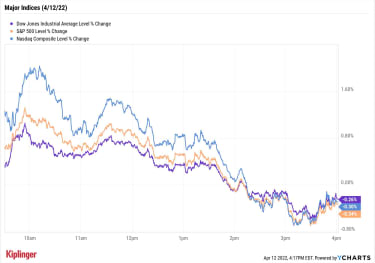Today’s much-awaited March inflation figures showed prices rocketing at their quickest pace in more than four decades. And yet, the report appeared poised to drive stocks higher … right up until it didn’t.
The Labor Department said Tuesday that March’s consumer price index (CPI) rose 8.5% year-over-year – the fastest such rate since December 2021 and ahead of broader expectations of 8.4%, though shy of Kiplinger forecasts – and 1.2% month-over-month.
There was a shred of good news in the core CPI reading, which excludes food and energy prices. Core prices grew 6.5% year-over-year, but just 0.3% month-over-month, below forecasts for 0.3% and down from February’s 0.5% rate.
“Inflation optimists may take this as a sign that inflation is peaking, or has already peaked and may now begin to decline,” says Andy Sparks, head of portfolio management research at index provider MSCI.
Those optimists drove the major indexes to significant gains right after the opening bell, but the bulls’ energy was depleted early, and selling dominated the rest of the day as Wall Street further absorbed the consumer-price figures.
Sign up for Kiplinger’s FREE Investing Weekly e-letter for stock, ETF and mutual fund recommendations, and other investing advice.
“Momentum in core inflation still looks too strong,” says Bill Adams, chief economist for Comerica Bank. “The biggest part of this is surging costs of rents and owners’ equivalent rent of primary residence. These CPI components are stickier than other consumer prices; they rose at the fastest rates in 20 years in March, and they are accelerating.”
Adams adds that housing-related costs in the consumer price index tend to follow home-price indexes such as the Case-Shiller and FHFA with a lag of between six and 18 months.
“This will continue to be a driver of hot inflation well into 2023,” he says.
Energy stocks (+1.7%) surged, largely because of a boom in U.S. crude oil futures, which finished up 6.7% to $100.60 per barrel after Shanghai eased some of its COVID-related lockdowns.
But the rest of the market let early gains slip. The Dow Jones Industrial Average (-0.3% to 34,220), S&P 500 (-0.3% to 4,397) and Nasdaq Composite (-0.3% to 13,371) all closed out Tuesday’s session with modest declines.
YCharts
Other news in the stock market today:
The small-cap Russell 2000 managed to finish 0.3% in the green, to 1,986.Gold futures climbed 1.4% to settle at $1,976.10 an ounce, marking their fourth straight gain.Bitcoin dipped below the $40,000 mark, off 1.8% to $39,324.96. (Bitcoin trades 24 hours a day; prices reported here are as of 4 p.m.)CarMax (KMX) was a notable decliner today, falling 9.5% following the used car company’s earnings report. In its fourth quarter, KMX reported revenue of $7.7 billion, up 49% year-over-year and more than analysts were expecting. But CarMax’s earnings of 98 cents per share were 22.8% lower than the year-ago period and below Wall Street’s consensus estimate. “We believe a number of macro factors weighed on our fourth-quarter unit sales performance, including declining consumer confidence, the omicron-fueled surge in COVID cases, vehicle affordability, and the lapping of stimulus benefits paid in the prior year period,” said CarMax CEO Bill Nash in a statement.Several energy stocks rose alongside oil prices today. Marathon Oil (MRO, +4.2%), Devon Energy (DVN, +3.7%) and EOG Resources (EOG, +2.7%) were among some of the day’s biggest advancers.Keep Guarding Against InflationThe name of the game, then, remains defense, with strategists continuing to suggest inflation protection until economic data signals otherwise.
Gargi Chaudhuri, head of investment strategy, Americas, for ETF provider iShares, says her firm favors “a diversified, multi-asset approach to navigate higher prices.”
First, in equities, “companies with pricing power, strong balance sheets, and healthy profit margins, like those in the technology and healthcare sectors, should do well as inflation stays higher than average,” she says. You can start your search among our top tech stocks and healthcare picks for the year, both of which boast a number of highly favored blue chips.
“In bonds,” Chaudhuri continues, “we like inflation-protected and short-term Treasuries and credit, which should benefit from sticky inflation and the Federal Reserve’s effort to tamp down inflation by raising rates.”
While dedicated investors can seek out individual debt issues, most of us typically get our fixed-income exposure through bond mutual funds and bond exchange-traded funds (ETFs).
On both fronts, our suggestions mirror Chaudhuri’s, with most of our recommendations designed to counter the effects of imminent inflation. Better still, our bond ETF picks can get you that kind of protection for a relative song. Read on as we highlight five fixed-income ETFs that also boast skinflint fees.
